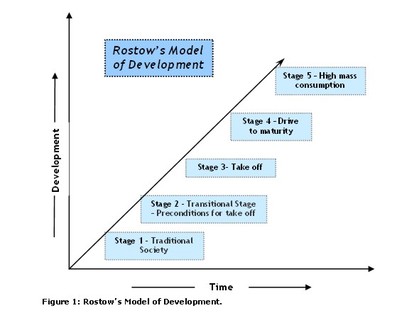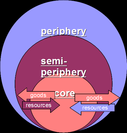Economic Geography

During this unit we will study:
A . Growth and diffusion of industrialization
1 . The changing roles of energy and technology
2 . Industrial Revolution
3 . Evolution of economic cores and peripheries
4 . Geographic critiques of models of economic localization
B. Contemporary patterns and impacts of industrialization and development including:
1 . Spatial organization of the world economy
2 . Variations in levels of development
3 . Deindustrialization and economic restructuring
4 . Globalization and international division of labor
5 . Natural resources and environmental concerns
6 . Sustainable development
7 . Local development initiatives: government policies
8 . Women in development
A . Growth and diffusion of industrialization
1 . The changing roles of energy and technology
2 . Industrial Revolution
3 . Evolution of economic cores and peripheries
4 . Geographic critiques of models of economic localization
B. Contemporary patterns and impacts of industrialization and development including:
1 . Spatial organization of the world economy
2 . Variations in levels of development
3 . Deindustrialization and economic restructuring
4 . Globalization and international division of labor
5 . Natural resources and environmental concerns
6 . Sustainable development
7 . Local development initiatives: government policies
8 . Women in development
Unit 6 Plan
| AP Unit 6 Plan Printable Version |
How Do You Define And Measure Development?
Development is the process of improving the material conditions of people through diffusion of knowledge and technology. A More developed country or (MDC)is a country that has progressed relatively far on the development continuum. Whereas a Less developed country or (LDC) is a country in an earlier stage of development. (Also sometimes called a developing country) Development is often measured by a country’s Gross Domestic Product or (GDP) which is the value of the total output of goods and services produced in a country per year.
The Human Development Index was developed as it was felt by many that it was unfair to measure ‘development’ solely on economic means . After all a country could have 50% of its population involved in farming and the population could be happy and well-fed. The HDI seeks to measure ‘quality of life’ not only GDP. However, as you will see from the presentation it above it too has it critics for emphasizing economic factors too much.
The Human Development Index was developed as it was felt by many that it was unfair to measure ‘development’ solely on economic means . After all a country could have 50% of its population involved in farming and the population could be happy and well-fed. The HDI seeks to measure ‘quality of life’ not only GDP. However, as you will see from the presentation it above it too has it critics for emphasizing economic factors too much.
Problems With The Term Development

The word developing suggests that all countries are improving their literacy rates, infrastructure or productivity per worker. It suggests that development is a scale or ladder, whereby all countries will either move up or down on the same process of development. This of course is not realistic, Sudan is not going to follow the same developmental pattern as Japan. Also, another criticism is the apparent Western bias in terms of the concept of development. In addition, most development models (Wallterstein aside) do not consider interrelations across scales, instead countries are treated an autonomous units moving thorough the process of development at different speeds.
Rostow's Model

The Rostow Model of Development was created in 1960 by an American, W.W.Rostow. He based the Model, which represents economic development, on 15 countries - most of which were European - and suggested that it was possible for all countries to break the viscious cycle of poverty and develop through the 5 linear stages that construct his model.
Stage 1: TRADITIONAL SOCIETY
Stage 2: PRE-CONDITIONS FOR TAKE-OFF
Stage 3: TAKE-OFF
Stage 4: DRIVE TO MATURITY
.
Stage 5: AGE OF HIGH MASS CONSUMPTION.
Stage 1: TRADITIONAL SOCIETY
Stage 2: PRE-CONDITIONS FOR TAKE-OFF
Stage 3: TAKE-OFF
Stage 4: DRIVE TO MATURITY
.
Stage 5: AGE OF HIGH MASS CONSUMPTION.
Strengths:
- It provides a general path for development and splits this path into 5 stages. This enables countries to use it as a rough guide to development.
- To some extent all countries can be compared to it.
- It is easy to understand.
- In conjunction with the Demographic Transition Model, it can be used to generate population policies.
Criticisms:
- The model is quite old (created in 1960) and, perhaps, oversimplified. Its age prevents it from taking into account new technological and scientific advances that have accelerated development.
- It is very Eurocentric and so perhaps reflects Westernization more than it does development as all countries develop differently and at different rates.
- The model makes the presumption that all countries start with the same foundations i.e have the same climate, amount of natural resources and same population size/structure and this is not in fact that case.
- Money is clearly needed for a country to move beyond stage 1 and often, nowadays this money is provided via international aid. However, debt repayments often restrict further advancements - something which is not taken into account in the model.
- This model is based on the development of countries like the UK. The development of the UK was, arguably at the expense of others, through colonialism. This model underestimates the importance of colonialism in the early development of many of the nations it is based on.
Effectiveness in the past and today
-Places such as the Maldives, Spain and New Caledonia have developed largely through Tourism not a switch from agriculture to manufacturing.
Key Points To Remember About Development:
Development happens in context: it is the combination of what is happening at a variety of scales concurrently.
When analyzing the development of a country we must consider what is happening locally, regionally and globally that affect that countries development. Local events which have had a regional or global impact are Greece defaulting on its debt (local) weakened the value of the Euro (regional) affected the value of other global currencies (global).
- It provides a general path for development and splits this path into 5 stages. This enables countries to use it as a rough guide to development.
- To some extent all countries can be compared to it.
- It is easy to understand.
- In conjunction with the Demographic Transition Model, it can be used to generate population policies.
Criticisms:
- The model is quite old (created in 1960) and, perhaps, oversimplified. Its age prevents it from taking into account new technological and scientific advances that have accelerated development.
- It is very Eurocentric and so perhaps reflects Westernization more than it does development as all countries develop differently and at different rates.
- The model makes the presumption that all countries start with the same foundations i.e have the same climate, amount of natural resources and same population size/structure and this is not in fact that case.
- Money is clearly needed for a country to move beyond stage 1 and often, nowadays this money is provided via international aid. However, debt repayments often restrict further advancements - something which is not taken into account in the model.
- This model is based on the development of countries like the UK. The development of the UK was, arguably at the expense of others, through colonialism. This model underestimates the importance of colonialism in the early development of many of the nations it is based on.
Effectiveness in the past and today
-Places such as the Maldives, Spain and New Caledonia have developed largely through Tourism not a switch from agriculture to manufacturing.
Key Points To Remember About Development:
Development happens in context: it is the combination of what is happening at a variety of scales concurrently.
When analyzing the development of a country we must consider what is happening locally, regionally and globally that affect that countries development. Local events which have had a regional or global impact are Greece defaulting on its debt (local) weakened the value of the Euro (regional) affected the value of other global currencies (global).
The Location of Industry
Why do industries locate where they do? How has the location of industry changed in MDC's and LDC's over the years?
Factors that affect industrial location
|
| ||||

